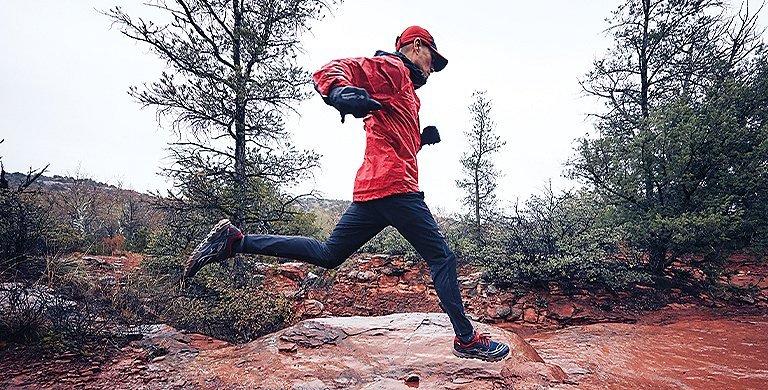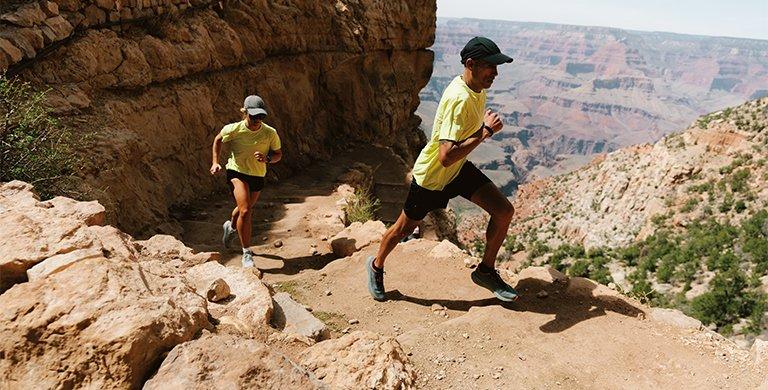TRAIL RUNNING
How Trail Jackets Have Evolved
To Be So Amazingly Lightweight
From giant military-style ponchos to nearly weightless shells that fit in the palm of your hand, trail gear has come a long way since its inception
BY RACHEL CAVANAUGH
Once upon a time, if you wanted to go trekking into the woods and stay warm or dry, you had to wrap yourself in military ponchos or drape your body in thick, heavy jackets made from bulky materials. Nowadays, however, rain shells are so lightweight that you can barely tell you’re wearing them. Not only that, they’re getting even lighter. So why did this happen? And how did science make it possible?
Members of the Chester Hale Troupe of Dancing Girls huddle under an umbrella wearing thick rain slickers in 1933.
The Origins of Trail Gear
Early outdoor gear had its roots in the military where coats were primarily made out of wool and natural fibers. Prior to that, people had used animal skins, relying on a system of trapping air to keep themselves warm. If you wanted to stay warm outside, you needed to pile on lots of thick layers and bulky garments.
Older rain slickers were coated in polyurethane, which was not only heavy but poorly ventilated. As technology evolved, however, brands began developing ways of making fabrics more lightweight and compact. Waterproof membranes emerged that could be put on textiles, cutting down on the weight and making the material softer and more breathable.
Older rain slickers were coated in polyurethane, which was not only heavy but poorly ventilated. As technology evolved, however, brands began developing ways of making fabrics more lightweight and compact. Waterproof membranes emerged that could be put on textiles, cutting down on the weight and making the material softer and more breathable.
Columbia Sportswear CEO Tim Boyle is pictured here in the 1970s working on an early raincoat prototype.
“Over the years, we've been able to engineer fabrics and laminations to get a lot more lightweight,” explained Becca Johnson, senior apparel designer for Columbia Sportswear. “The game changer came when we invented OutDry Extreme technology. That took the breathable waterproof membrane and put it on the outside of the jacket, which eliminated the problem of water soaking the outer layer.”
Using membranes and laminations on fabrics allowed the textiles themselves to be thinner too. Additionally, it meant that the mesh liners that were common in most older rain jackets were no longer needed.
“With a traditional rain jacket with the membrane against your skin, it's going to feel tacky or sticky—that's why you put a mesh lining or a fabric on it,” Johnson explained.
“But with the OutDry, you're able to eliminate a layer of fabric because you already have textile against your skin and you don't have that textile on the outer shell."
Using membranes and laminations on fabrics allowed the textiles themselves to be thinner too. Additionally, it meant that the mesh liners that were common in most older rain jackets were no longer needed.
“With a traditional rain jacket with the membrane against your skin, it's going to feel tacky or sticky—that's why you put a mesh lining or a fabric on it,” Johnson explained.
“But with the OutDry, you're able to eliminate a layer of fabric because you already have textile against your skin and you don't have that textile on the outer shell."
Since its launch in 2016, Outdry Extreme technology has evolved to become exceptionally lightweight.
Evolution of the Sport
Part of the reason things changed so dramatically is that when people first began hiking recreationally, it was a more uniform sport. All trail gear was essentially designed for the same thing and people usually only had one jacket for the outdoors. That meant jackets needed to be more versatile.
However, trail sports today are extremely diverse. There’s weekend backpacking, day hiking, thru-hiking, trail running, adventure trekking, aerobic fast-hiking, and more, which means jackets can be targeted to more specific uses.
Aerobic hiking and multiday excursions specifically have created a demand for a more lightweight rain shell.
“You used to need to have a lot more versatility out of your jacket because you would buy one jacket to do every single activity,” Johnson said.
The most recent iteration is Columbia Sportswear’s ODX Nanolite Shell, which weighs just 7.1 ounces.
“We've created a very, very light textile that we were able to bind to the OutDry,” Johnson said. “And because we put it on such a featherweight textile, it's made it incredibly lightweight and incredibly packable. It almost feels like you're wearing nothing because of how light we were able to get it.”
However, trail sports today are extremely diverse. There’s weekend backpacking, day hiking, thru-hiking, trail running, adventure trekking, aerobic fast-hiking, and more, which means jackets can be targeted to more specific uses.
Aerobic hiking and multiday excursions specifically have created a demand for a more lightweight rain shell.
“You used to need to have a lot more versatility out of your jacket because you would buy one jacket to do every single activity,” Johnson said.
The most recent iteration is Columbia Sportswear’s ODX Nanolite Shell, which weighs just 7.1 ounces.
“We've created a very, very light textile that we were able to bind to the OutDry,” Johnson said. “And because we put it on such a featherweight textile, it's made it incredibly lightweight and incredibly packable. It almost feels like you're wearing nothing because of how light we were able to get it.”
In addition to the convenience factor, lighter trail gear has a number of practical uses too. Johnson explained that long-distance trail hikers go to great extremes to shave off weight.
“I interviewed some Pacific Crest trail hikers a couple of years ago and they were talking about what they put in their backpacks,” she said. “There's a certain breed of hikers—these ultralight hikers—that are cutting holes in their toothbrushes just to take ounces out of their backpack. Their thought is that over thousands of miles, those ounces add up to a lot of pounds.”
It’s hikers like those who love the Nanolite the most, she said, although regular day hikers like being able to throw a lightweight shell in their pack without lugging around a lot of extra bulk. Lightweight rain shells are also nice to have when traveling, she added.
In addition to the convenience, having lightweight gear is easier on your body, and if it makes you bring a raincoat more often, it can potentially be safer too. “Getting your gear as lightweight as possible puts less strain on your body, which is an important thing to consider,” Johnson said. “In some cases, a rain shell can be a life-or-death piece of clothing. If you're in a really bad storm or if you get soaked through all the way down to your core, that's not going to be good.” Additionally, having a technical piece of clothing that’s only a fraction of the size gives you room for other things, whether it’s your favorite camp shoes or an important piece of emergency equipment.
Haley Stewart, a backpacker from Oregon, said she spends a lot of time trying to find ways to reduce weight on her treks.
“I tend to do day hiking, car camping, snowshoeing, and multiday backpacking,” Stewart said. “I've done thru-hiking as well as out-and-back trips. Whether it's for a four-hour or four-day hike, I always want ultralightweight gear when I'm on the trail. The longer the distance, the more I want lighter gear to make room for food, water, and other essential items.
“This is especially true for backpacking trips in areas without reliable access to water. If I have to pack in water, I'm willing to sacrifice other items just to keep my pack as light as possible.”
Johnson said she thinks jackets and trail gear will only continue to get more lightweight as technology continues evolving.
Stewart agreed.
“I definitely think gear will continue to get lighter,” she said. “We've come a long way in creating lightweight gear, but it seems like companies are always finding new designs and new materials.”
“I interviewed some Pacific Crest trail hikers a couple of years ago and they were talking about what they put in their backpacks,” she said. “There's a certain breed of hikers—these ultralight hikers—that are cutting holes in their toothbrushes just to take ounces out of their backpack. Their thought is that over thousands of miles, those ounces add up to a lot of pounds.”
It’s hikers like those who love the Nanolite the most, she said, although regular day hikers like being able to throw a lightweight shell in their pack without lugging around a lot of extra bulk. Lightweight rain shells are also nice to have when traveling, she added.
In addition to the convenience, having lightweight gear is easier on your body, and if it makes you bring a raincoat more often, it can potentially be safer too. “Getting your gear as lightweight as possible puts less strain on your body, which is an important thing to consider,” Johnson said. “In some cases, a rain shell can be a life-or-death piece of clothing. If you're in a really bad storm or if you get soaked through all the way down to your core, that's not going to be good.” Additionally, having a technical piece of clothing that’s only a fraction of the size gives you room for other things, whether it’s your favorite camp shoes or an important piece of emergency equipment.
Haley Stewart, a backpacker from Oregon, said she spends a lot of time trying to find ways to reduce weight on her treks.
“I tend to do day hiking, car camping, snowshoeing, and multiday backpacking,” Stewart said. “I've done thru-hiking as well as out-and-back trips. Whether it's for a four-hour or four-day hike, I always want ultralightweight gear when I'm on the trail. The longer the distance, the more I want lighter gear to make room for food, water, and other essential items.
“This is especially true for backpacking trips in areas without reliable access to water. If I have to pack in water, I'm willing to sacrifice other items just to keep my pack as light as possible.”
Johnson said she thinks jackets and trail gear will only continue to get more lightweight as technology continues evolving.
Stewart agreed.
“I definitely think gear will continue to get lighter,” she said. “We've come a long way in creating lightweight gear, but it seems like companies are always finding new designs and new materials.”
Ready to get out on the trail? Check Out Columbia Sportswear’s selection of lightweight trail jackets



